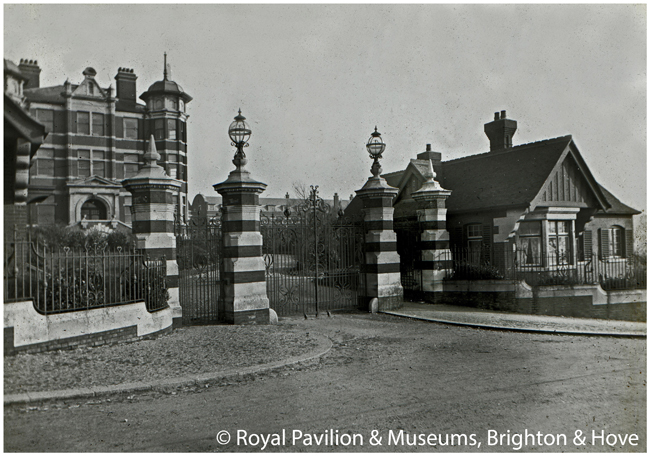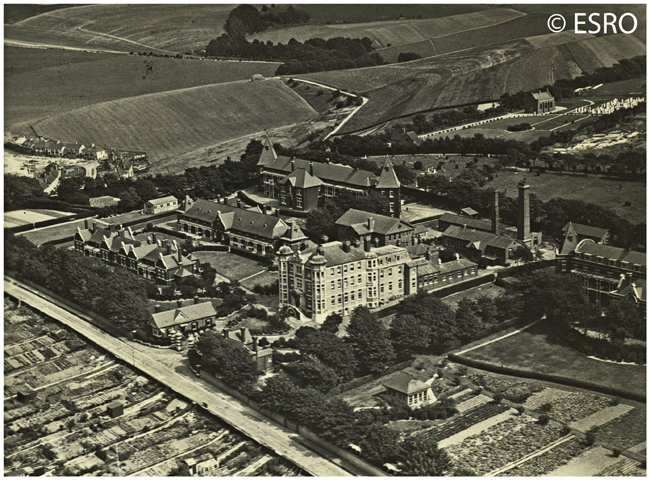
The Estate - Bevendean History Project

The Bevendean Hospital part 3

Bevendean Hospital from 1910 to the 1940s
Porters Lodge and Gates for the Bevendean Sanatorium, Brighton c1910. The Administration Block can be seen in the background.

Later between 1902-1905; two two-storied Pavilions were built, one of these was then used as the Scarlet Fever Ward on the south-east of the Administration Building. Both floors in the other Pavilion were used for patients suffering from consumption or tuberculous joints. This was sited north east the Administrative. The total cost of these two Pavilions was £27,840. In 1905, a large shelter was erected for the male consumptive patients at a cost of £164, and about 1910 a small revolving shelter, for use by female patients, was presented to the hospital.
By 1910 the Isolation Hospital consists of four main pavilions for infectious cases, an administrative block, the Borough disinfecting station, a laundry, and a small destructor.
The population of Brighton, estimated to the middle of 1910, was 181,900; this gave a proportion of beds to the population of about 1 to 800.
If severe epidemics of diphtheria and scarlet fever occurred at the same time it would have become necessary to alter these arrangements, or even to send home the patients with tuberculosis T.B. (called consumption in the early 1900).
Consumption or T.B.
In Brighton consumptives were admitted to the Isolation Hospital for the first time in May, 1902. At first only a small number of beds were available, but later on this number was considerably increased. Since the education of the patients was the principal object, they were kept for only a short period, about four weeks. However, in certain cases patients were kept for much longer periods. Persons suffering from consumption were admitted in all stages of the disease. No charge was made. The only conditions made were that the patient was notified to the Medical Officer of Health and had resided two years in Brighton immediately prior to admission to the Sanatorium.
Consumptives, with the exception of children, are housed in Ward No. 5, which was the ground floor of a two-storied building originally intended for diphtheria. This building stands on the highest part of the Sanatorium grounds and faces west.
It was not been found practicable to set the consumptives to routine out-door work, comparatively few early cases being admitted. Those who were fit for exercise take it by walking on the Downs in the vicinity of the Sanatorium. Except in bad weather the patients for the most part lived and many sleep out of doors.
In the majority of cases the patient's condition was very materially improved by residence at the Sanatorium, though it was only in the less advanced cases that the condition of the lungs appears to be materially improved.
The education of the patients about their condition and how to cope was of great value to them. They learnt to appreciate the great benefit of unlimited fresh air, and become alive to the scrupulous care that is necessary in coughing and spitting, and the disposal of the sputa for the safe-guarding of those with whom they live.
Up to the end of 1909, over eleven hundred patients suffering from consumption had been admitted, on at least one occasion, to the hospital wards. The weekly cost of each patient, was estimated at about 25/-.
Tuberculous Joints
A recent departure (1910) was in the treatment of early cases of tuberculous joint disease. Spinal, hip, and knee cases were treated. Those cases require absolute rest over prolonged periods, to avoid deformity and crippling. Complete rest was not possible in working class houses, and the general hospitals did not have spare beds to keep such cases for nine months or more until a complete cure was affected. The result was that many of the children with tuberculous joints become permanent cripples.
The Municipal Laboratory
Since 1898 bacteriological work has been carried on by the Brighton Public Health Department, with the object of facilitating the early diagnosis of tuberculosis, diphtheria, and other infectious diseases.
Before the present laboratory was adapted to the purpose about 1902, the work was carried on for a time at the Municipal Technical School.
To illustration the work of the laboratory, the numbers of different kinds of specimens examined in 1909 were as follows:—
In addition the Municipal Laboratory serves for the routine examination of Brighton's five sources of water, each of which is examined once a month both chemically and bacterioscopically.
It was not possible to estimate accurately the annual cost of the Laboratory, since there is no means of separating the amounts of water, gas, and electricity consumed there from those consumed in the other parts of the Sanatorium. It was estimated that the annual cost, including the wages of an experienced assistant, did not exceed £100.
The cost of apparatus and material for a year was about £23.
Between the First and Second World Wars, extra accommodation for nurses was constructed adjacent to the main building. This was to the north east of the rear of the large administration block, as shown in the aerial photograph below taken in 1933.

Bevendean Hospital from 1910 to the 1940s
Porters Lodge and Gates for the Bevendean Sanatorium, Brighton c1910. The Administration Block can be seen in the background.

Later between 1902-1905; two two-storied Pavilions were built, one of these was then used as the Scarlet Fever Ward on the south-east of the Administration Building. Both floors in the other Pavilion were used for patients suffering from consumption or tuberculous joints. This was sited north east the Administrative. The total cost of these two Pavilions was £27,840. In 1905, a large shelter was erected for the male consumptive patients at a cost of £164, and about 1910 a small revolving shelter, for use by female patients, was presented to the hospital.
By 1910 the Isolation Hospital consists of four main pavilions for infectious cases, an administrative block, the Borough disinfecting station, a laundry, and a small destructor.
| In the scarlet fever pavilion (2 storeys) | 68 beds |
| In the consumption pavilion (2 storeys) | 56 beds |
| In the diphtheria pavilion | 22 beds |
| In the isolation pavilion | 14 beds |
| Total | 160 beds |
The population of Brighton, estimated to the middle of 1910, was 181,900; this gave a proportion of beds to the population of about 1 to 800.
If severe epidemics of diphtheria and scarlet fever occurred at the same time it would have become necessary to alter these arrangements, or even to send home the patients with tuberculosis T.B. (called consumption in the early 1900).
Consumption or T.B.
In Brighton consumptives were admitted to the Isolation Hospital for the first time in May, 1902. At first only a small number of beds were available, but later on this number was considerably increased. Since the education of the patients was the principal object, they were kept for only a short period, about four weeks. However, in certain cases patients were kept for much longer periods. Persons suffering from consumption were admitted in all stages of the disease. No charge was made. The only conditions made were that the patient was notified to the Medical Officer of Health and had resided two years in Brighton immediately prior to admission to the Sanatorium.
Consumptives, with the exception of children, are housed in Ward No. 5, which was the ground floor of a two-storied building originally intended for diphtheria. This building stands on the highest part of the Sanatorium grounds and faces west.
It was not been found practicable to set the consumptives to routine out-door work, comparatively few early cases being admitted. Those who were fit for exercise take it by walking on the Downs in the vicinity of the Sanatorium. Except in bad weather the patients for the most part lived and many sleep out of doors.
In the majority of cases the patient's condition was very materially improved by residence at the Sanatorium, though it was only in the less advanced cases that the condition of the lungs appears to be materially improved.
The education of the patients about their condition and how to cope was of great value to them. They learnt to appreciate the great benefit of unlimited fresh air, and become alive to the scrupulous care that is necessary in coughing and spitting, and the disposal of the sputa for the safe-guarding of those with whom they live.
Up to the end of 1909, over eleven hundred patients suffering from consumption had been admitted, on at least one occasion, to the hospital wards. The weekly cost of each patient, was estimated at about 25/-.
Tuberculous Joints
A recent departure (1910) was in the treatment of early cases of tuberculous joint disease. Spinal, hip, and knee cases were treated. Those cases require absolute rest over prolonged periods, to avoid deformity and crippling. Complete rest was not possible in working class houses, and the general hospitals did not have spare beds to keep such cases for nine months or more until a complete cure was affected. The result was that many of the children with tuberculous joints become permanent cripples.
The Municipal Laboratory
Since 1898 bacteriological work has been carried on by the Brighton Public Health Department, with the object of facilitating the early diagnosis of tuberculosis, diphtheria, and other infectious diseases.
Before the present laboratory was adapted to the purpose about 1902, the work was carried on for a time at the Municipal Technical School.
To illustration the work of the laboratory, the numbers of different kinds of specimens examined in 1909 were as follows:—
| Total number of Swabs | 3,636 |
| Total number of Sputa | 523 |
| Total number of Serums | 84 |
| Examinations of hairs for Ringworm | 165 |
| Miscellaneous | 33 |
| Total | 4,441 |
In addition the Municipal Laboratory serves for the routine examination of Brighton's five sources of water, each of which is examined once a month both chemically and bacterioscopically.
It was not possible to estimate accurately the annual cost of the Laboratory, since there is no means of separating the amounts of water, gas, and electricity consumed there from those consumed in the other parts of the Sanatorium. It was estimated that the annual cost, including the wages of an experienced assistant, did not exceed £100.
The cost of apparatus and material for a year was about £23.
Between the First and Second World Wars, extra accommodation for nurses was constructed adjacent to the main building. This was to the north east of the rear of the large administration block, as shown in the aerial photograph below taken in 1933.

